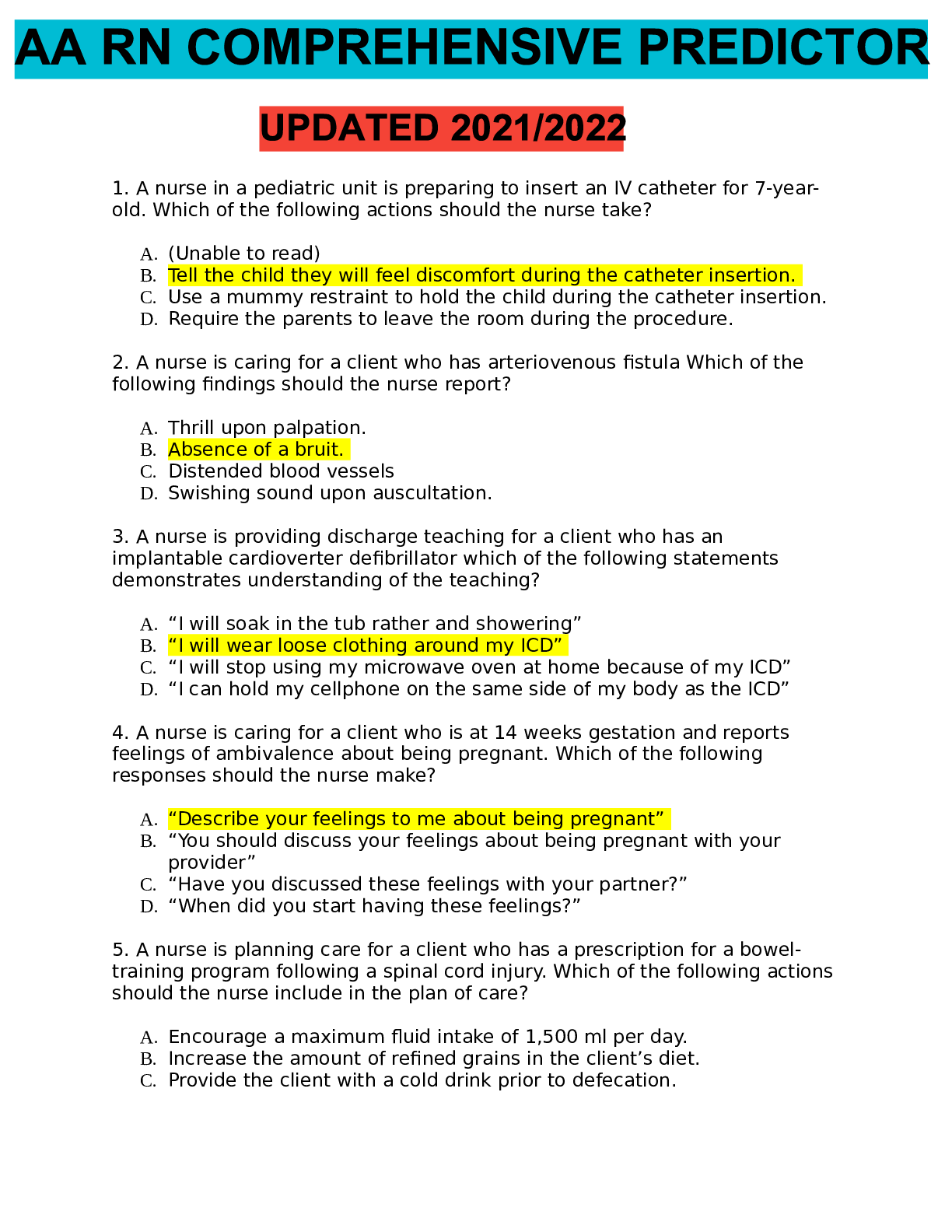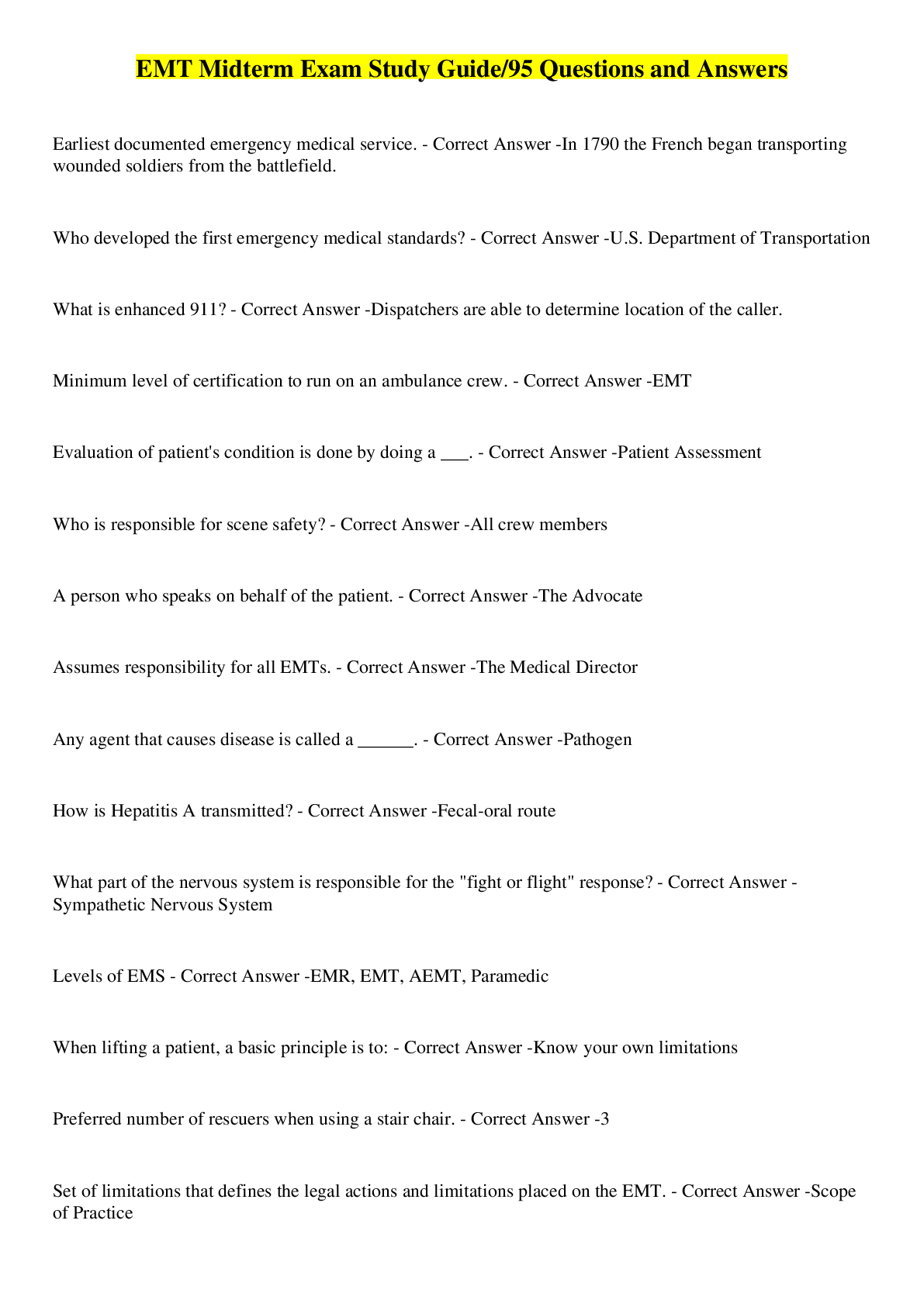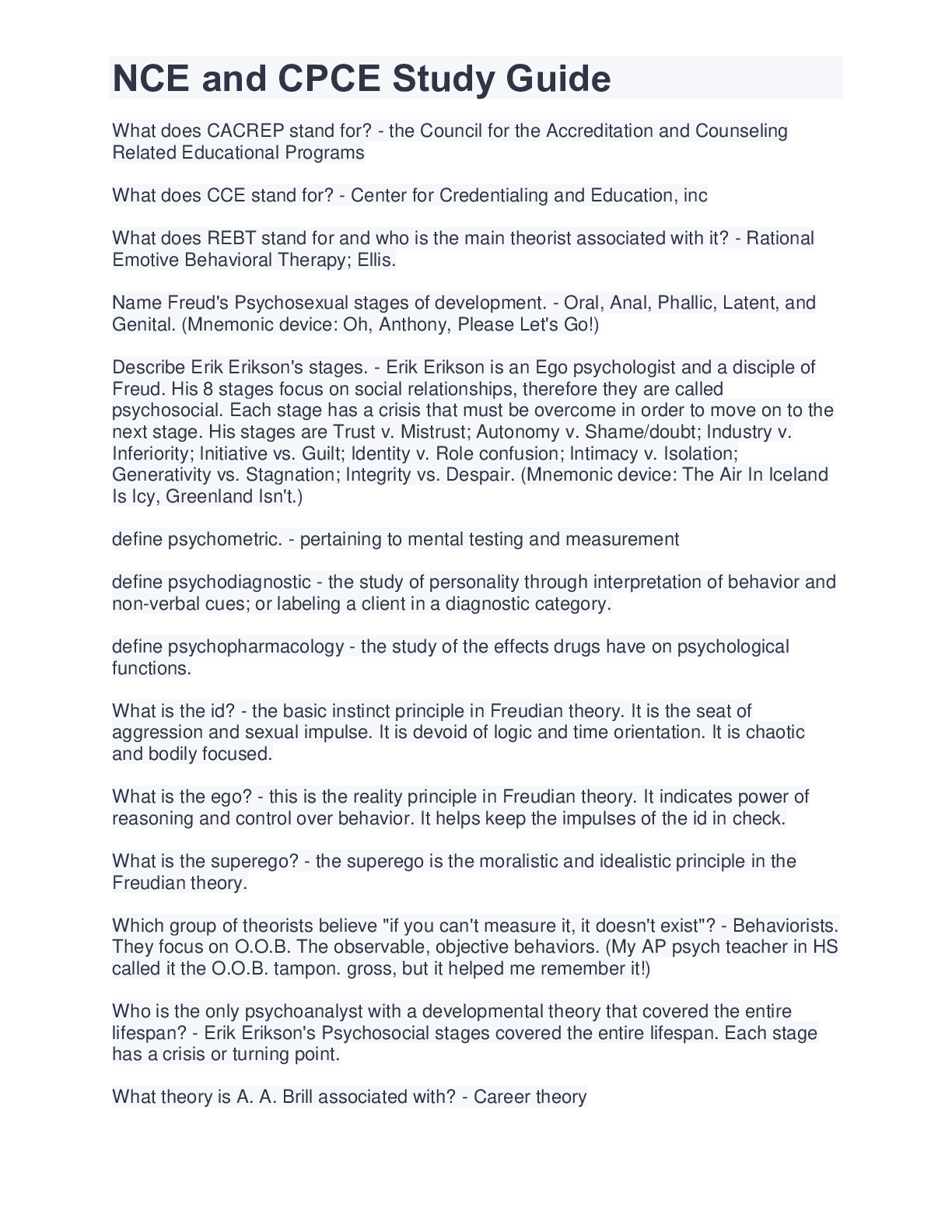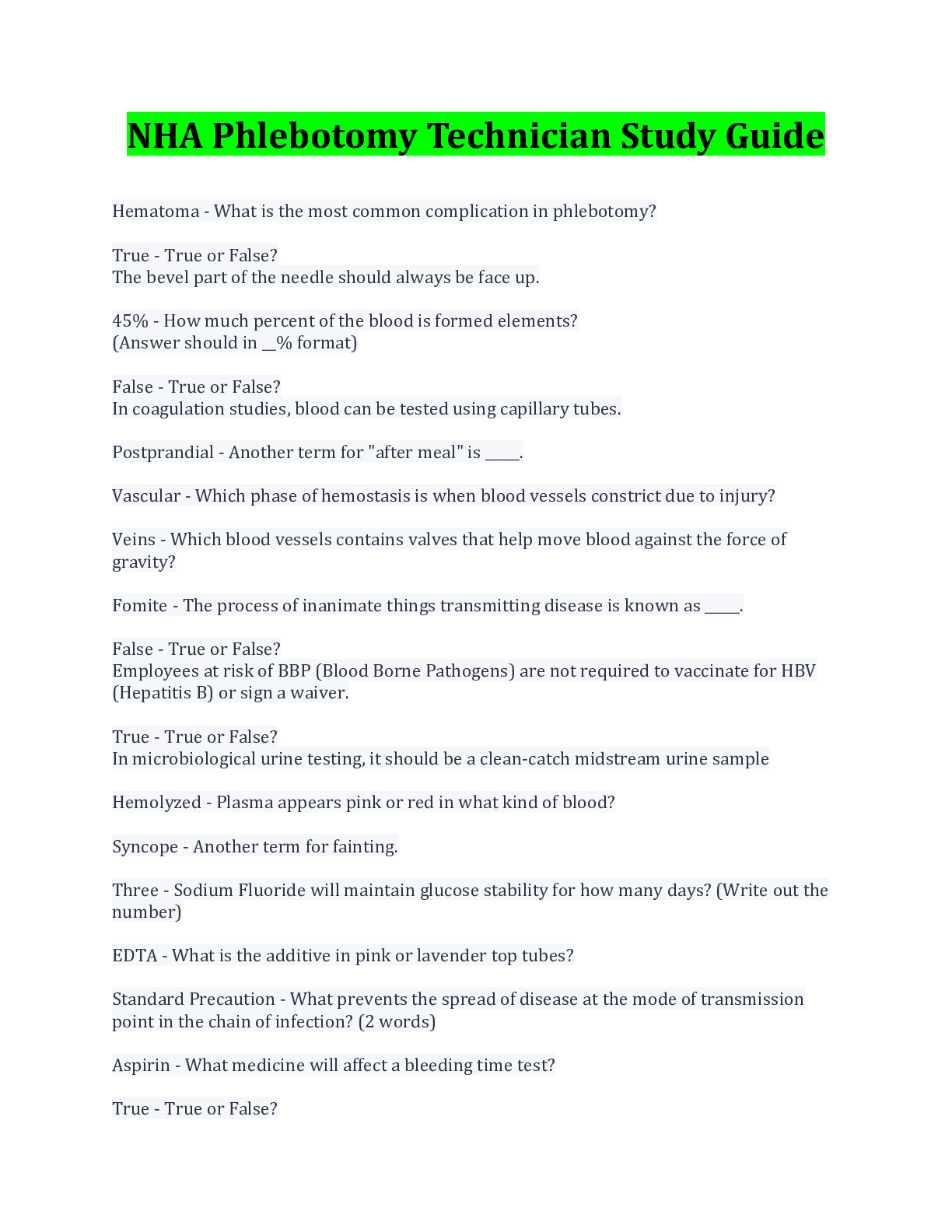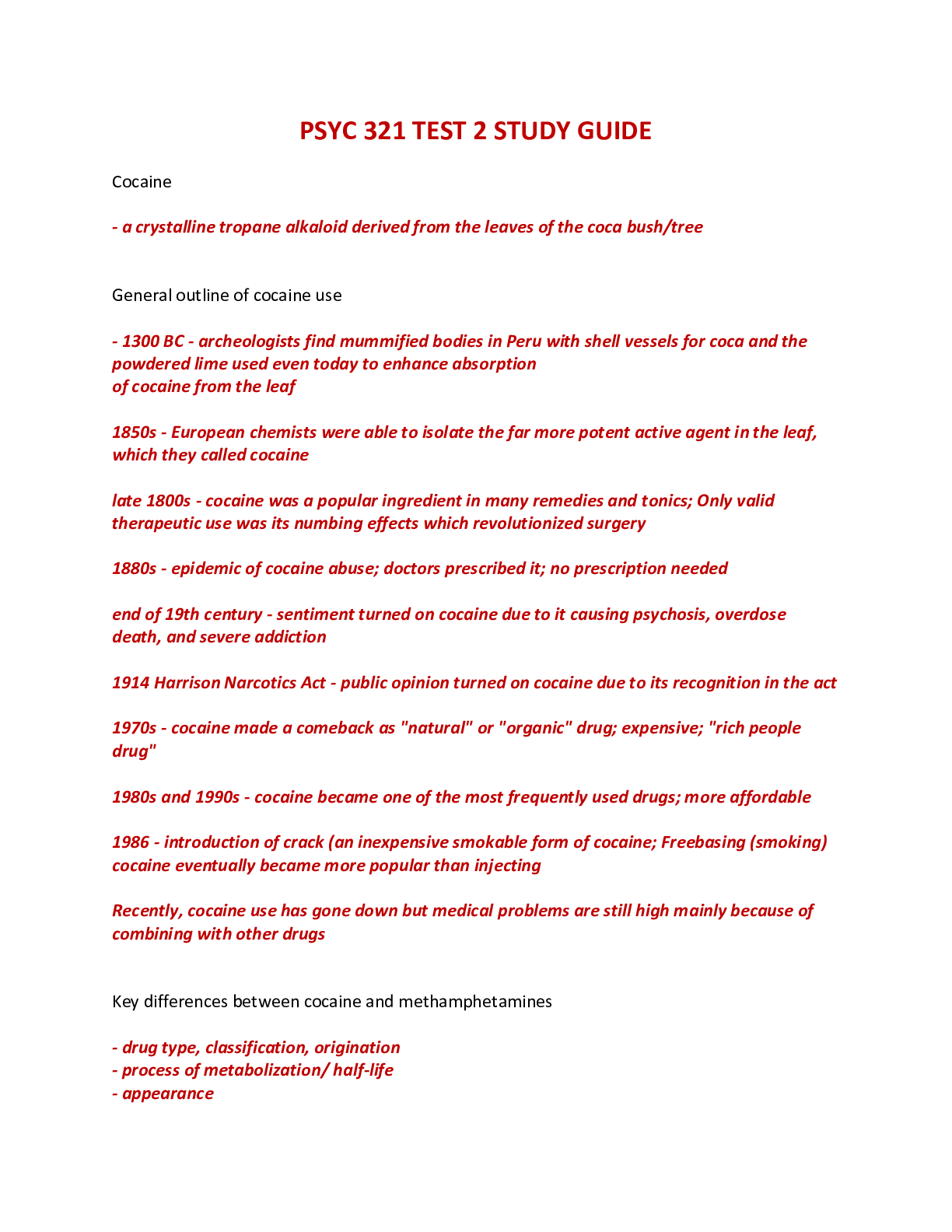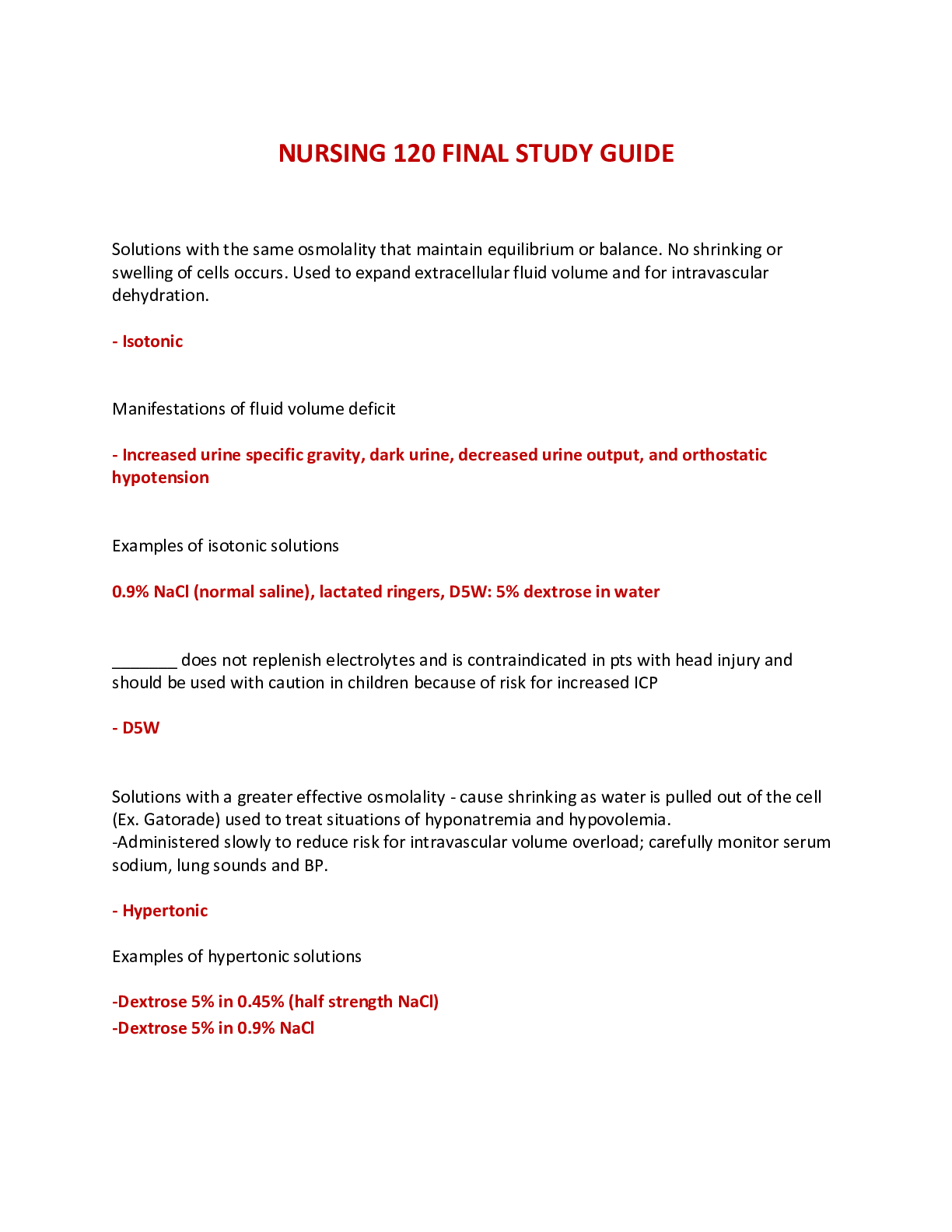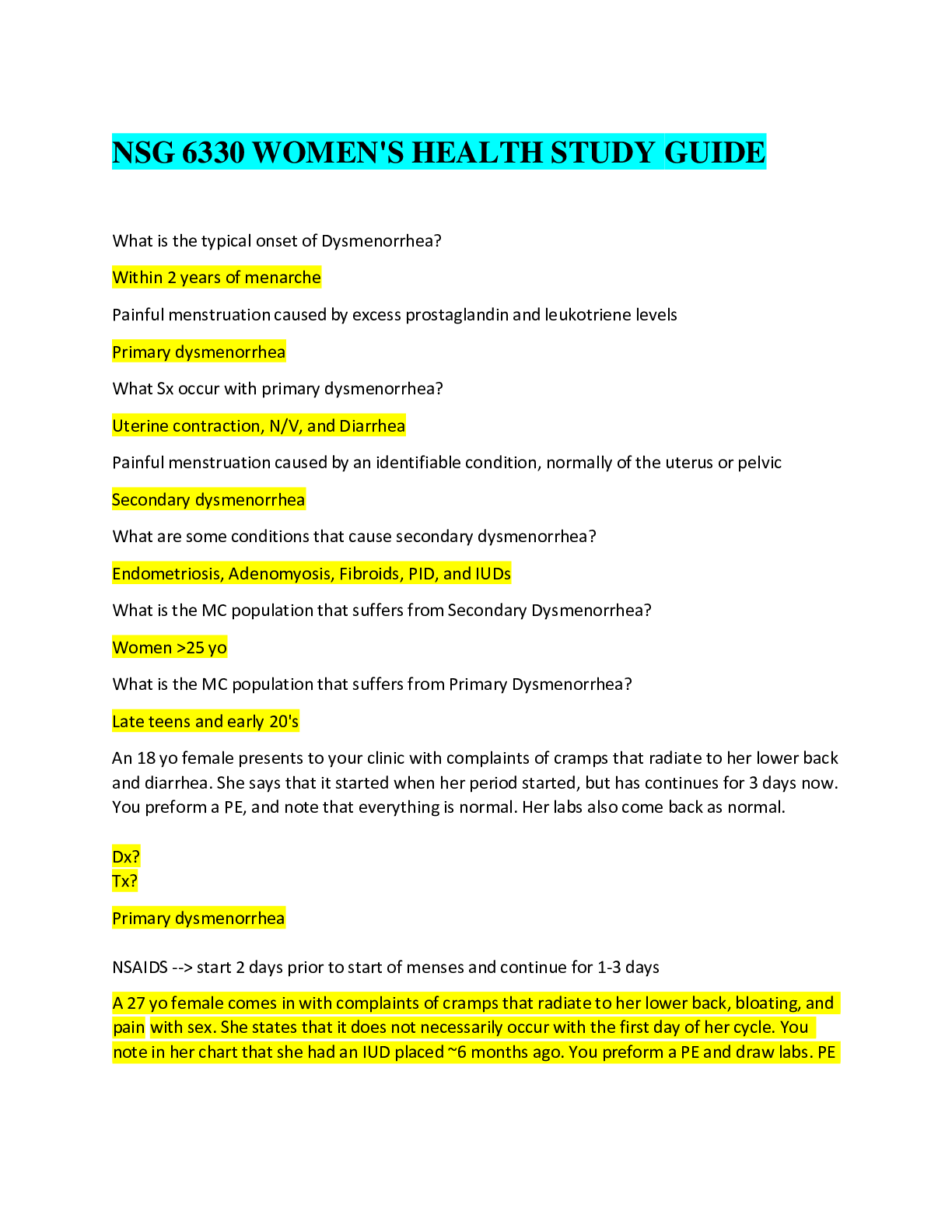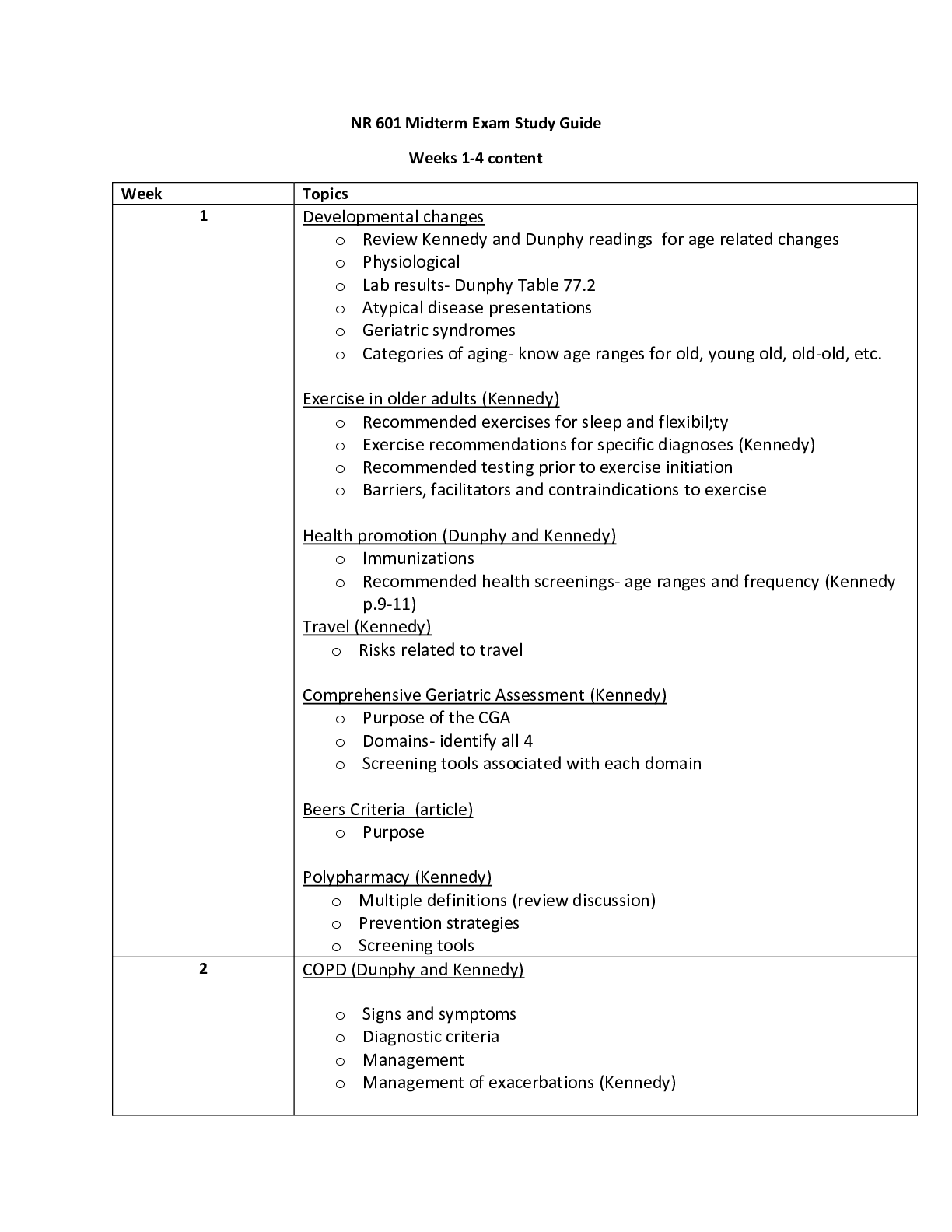Medicine > STUDY GUIDE > Maternal Newborn Exam Study Guide (NCC) (All)
Maternal Newborn Exam Study Guide (NCC)
Document Content and Description Below
Maternal Newborn Exam Study Guide (NCC) A woman with a BMI of 18 gains 25 lbs during her pregnancy. This pregnancy is at increased risk for a. cesarean delivery b. Delivery of low birthweight deliv... ery c. preeclampsia During pregnancy, which of the following cardiovascular parameters increases by 60% a. blood volume b. plasma volume c. red cell mass When pregnancy, a woman with epilepsy has a higher risk of seizures a. during labor through 24 hours postpartum b. from 72 hours to 1 week pp c. in the third trimester The risk of developing diabetes in women with a history of gestational diabetes is a. increased only if there are also multiple diabetes risk factors b. increased with onset within 10-15 years in about 50% of those women c. the same as women who do not have gest. diabetes A woman receives magnesium sulfate during labor for gestational hypertension. What effect can this have on newborn? a. elevated cortisol levels b. hypoglycemia c. muscle weakness A pregnant woman was diagnosed with varicella-zoster at 32 weeks gestation. She is now in active labor at 40 weeks gestation. The nurse would expect that which of the following would be appropriate in order to ensure the health of the newborn. a. administer zoster immunoglobulin to newborn at delivery b. administer zoster immunoglobulin to patient before delivery c. the mother's antibodies will be protective so no action is needed In order to decrease the risk of fetal death to that of a non-smoker, a woman must quit smoking a. before the pregnancy occurs b. by the end of the first trimester c. by the end of the 2nd trimester A patient in preterm labor at 30 weeks received indocin, the newborn should be observed for? a. duodenal atresia b. Hirschsprung disease c. necrotizing entercolitis (NEC) What are the characteristics of dizygotic pregnancy? a. 1 placenta and 1 amniotic sac b. 1 placenta and 2 amniotic sacs c. 2 placentas and 2 amniotic sacs A woman is diagnosed with oligohydramnios during her pregnancy. the fetus/newborn should be evaluated for a. diabetes insipidus b. klippel-feil syndrome c. polycystic kidney disease A fetus at 36 weeks receives a BBP score of 6. The expected management is a. immediate delivery b. repeat in 24 hrs c. schedule the next test in one week In evaluating the patient census for staff assignments, the pp nurse is told that a patient in the high risk unit may be delivered and transferred to pp after delivery. A L/S ratio was performed with result of 2:0 the nurse would expect the following to occur? a. A PG (phosphatidyglycerol) test needs to be performed b. the lungs are mature, and delivery will occur c. the lungs are still immature, and the L/S will be repeated in 1 week Which of the following is a limitation of an alpha-fetaprotein (AFP) test? a. closed neural tube defects are not detected b. it will not detect down syndrome c. its best sensitivity is at 20 weeks A postpartum woman's prenatal history shows a quad screen with a maternal serum (MSAFP) lower than normal and higher than HCG and Inhibin A. The nurse can expect the diagnosis of the newborn? a. neural tube defect b. Trisomy 21 c. Underestimated gestational age An umbilical gas ( artery) reveals the following ph: 7.27, PC02: 50mm Hg; HC03: 23 meq/Ll base excess -3.6. This represents a. normal value b. metabolic acidosis c. respiratory acidosis Umbrical blood gas values are used to? a. determine etiology of any immediate complication b. direct neonatal resuscitation efforts c. establish the metabolic status of the fetus Ultrasound for antepartum testing uses high frequency sound waves to produce an image that varies based on the a. amount of fetus moves b. density of the structure under the transducer c. strength of the reflected energy In evaluating a cord blood gas, if the pH is low, what other blood gas parameter is used to determine if the acidosis is respiratory or metabolic? a. PC02 b. HCO3 c. Po2 Breech presentation increases risk for a. cord prolapse b. fetal clavicle fracture c. shoulder dystocia A newly delivered postpartum patient received terb and corticosteroids during labor. A potential drug interaction that the pp nurse should watch for in the woman is a. hyperglycemia b. ketoacidosis c. pulmonary edema A postpartum patient has a spinal headache. The nurse knows that this can occur as a consequence of epidural due to a. injured nerve pathways b. puncture of the dura c. too rapid administration Shoulder dystocia places the pp woman at increased risk for a. endometritis b. hemorrhage c. urinary retention A newborn is at a higher risk for jaundice when delivered by a. cesarean section b. forceps c. vacuum A woman who is 4 hr pp asks the nurse how much weight she might have lost with the deliver. The nurse would know to tell her the average wgt loss at birth is a. 10 lbs b. 12 lbs c. 14 lbs When assessing a woman who is 1 day pp, the nurse would expect her fundus to be palpated a. at umbilicus b. 1cm above umbilicus c. 1cm below umbilicus Within the first 2 days after birth, progesterone levels fall causing what acid base change? a. Increased PaCO2 b. Decreased PCO2 c. Decreased PaO2 Compared to the value seen in the 3rd trimester, the catabolic process of involution causes an increase in which of the following values pp? a. BUN b. creatinine clearance c. proteinuria A pp patient on her 2nd day is concerned that she has been urinating large amounts and frequently. Her output is 3000ml, the appropriate response by the nurse a. contact her care provider for an antibiotic order b. explain that this is a normal physiologic response to delivery c. obtain a clean catch urine Forceps delivery can result in what complication in the newborn? a. blood clots b. craniosynotosis c. nerve injuries To avoid a precipitous drop in intra-abdominal pressure during catheterization of a postpartum patent’s bladder, what is the maximum amount of urine that should be removed at one time? a.700 ml b. 800ml c. 900 ml A woman is 12 hours pp and has a WBC of 25,000 this indicates a. an expected range b. dehydration and a need to force c. infection and a need for an antibiotic order During pp, the low levels of placental lactogen, estrogen, cortisol, growth hormone, and insulinase result in a. diuresis b. increased angiotensin II c. lower glucose levels 2 hours after delivery an examination of the uterine fundus finds it deviated from midline. The nurse should have the woman a. flex her legs and reassess b. further evaluated for infection c. void to empty the bladder When assessing a new pp patient, the nurse would expect her blood pressure to be a. consistent w baseline blood pressure during pregnancy b. increased from the work of labor c. lower than normal Following delivery, an insulin dependent diabetic will have her insulin dose reduced because. a. her metabolism is in a state of flux immediately pp b. nutritional intake is still low and activity c. the anti-insulin effect ceases after placental separation A woman who is 12 hours pp and has a history of asthma, is noted to have uterine atony. The patient's v/s are bp 150/90, pulse 100 and resp 14. Her temp is 99.4. The nurse would expect the medication appropriate a. hemabate b. methergine c. oxytocin Scopalamine is classified as a category 6 drug by the American academy of pediatrics. this means that the drug a. can be used during breastfeeding but watch for signs of poor feeding b. is compatible w breastfeeding c. should not be used while breastfeeding A nurse discovers that an order for rh immune globulin (RhoGam) to be given 72 hrs past delivery was missed. It has been 4 days and the pt is to be d/c home. Following standard medication error, what is the correct action regarding the administration of the RhoGam at this time? a. a Kleihauer-Betke smear should be obtained before administration of Rhogam b. Administer 300 mg of Rhogam c. Administer 300 mg of Rhogam now and check Kleihauer-Betke at 6 weeks A pp woman is given RH immune globin (Rhogam) at two days pp. the nurse would alert the woman to what possible side effects. a. increased lochia for a few hours following administration b. soreness at the site of injection site c. given at the same time. A pp woman has an order for Rh immune globulin and rubella vaccine the nurse knows that the rubella vaccine should be. a. administered at the pp office visit b. delayed until 24 hrs after the Rh immune globulin is administered c. given at same time The unsensitized Rh-negative mother whose baby is Rh positive should a. have the father's blood type determined b. receive 300 mcg of Rho (D) by 72 hrs of birth c. require no further treatment After pains are due to a. hormonal shifts that affect the muscle b. physiologic stress from the birth process c. uterine contractions during involution A pp woman who is not breastfeeding states that her mother recommends she bind her breast to prevent painful engorgement. The nurse would advise the patient that binding a. and an order for a diuretic will shorten the engorgement b. and restriction of fluids for 2 days is recommended c. may lead to more leaking The American Academy of Pediatrics recommend 400 IU of vitamin D supplement for all infants beginning at what age? a. 2 months b. 4 months c. soon after birth The lactation initiation stage is dependent on a. a cascade of hormonal changes b. early nursing or milk removal c. prolactin A new breastfeeding mother wants to begin a reduction diet to lose weight. The min number of kcal a lactating woman should consume per day is a. 1800 b.2000 c.2200 While in the hospital the mother of a breastfeeding term newborn is observed to have flat nipples and is having difficulty getting baby to latch on properly. The nurse should recommend a. nipple rolling b. nursing w a nipple shield c. wearing breast shells btw feedings A pt reports painful nipples. The nurse knows that a. a lack of nipple preparation can result in pain b. nursing too long can cause pain c. specific areas of pain can have a specific cause A pp mother who would like to breastfeed her baby is diagnosed w hepatitis A virus before delivery. What is the recommendation regarding breastfeeding for this patient? a. Administer immunoglobin and hepatitis antivirus vaccine to the newborn and allow nursing b. do not nurse due to the risk of horizontal transmission from the mother c. pump and discard milk for 1 week following vaccine administration to the newborn A pp mother diagnosed with cytomegalovirus (CMV) during 3rd trimester delivers a baby at 40 weeks. What is the recommendation regarding breastfeeding? a. breastfeed after delivery b. breastfeed after two or more weeks of treatment of the mother c. restrict breastfeeding until treatment is completed When deciding on a mechanical breast pump, which of the following features is the most important? a. cycle pressure sustained for 2 seconds or a rate of 30 pumps per min b. manually controlled pressure c. negative pressure of >250mm/hg to initiate milk flow The cause of sudden late onset of pp hemorrhage secondary to retained placental fragments is due to a. increased uterine contraction activity b. nectrotic tissue separation from the uterus c. weakness in the uterine musculature Clinical signs of hemorrhage such as b/p 90/70 pule 118, tachypnea can be seen when the blood loss reaches a. 900 b. 1200 c. 1800 [Show More]
Last updated: 11 months ago
Preview 4 out of 15 pages

Loading document previews ...
Buy this document to get the full access instantly
Instant Download Access after purchase
Buy NowInstant download
We Accept:

Reviews( 0 )
$15.00
Can't find what you want? Try our AI powered Search
Document information
Connected school, study & course
About the document
Uploaded On
Jul 13, 2024
Number of pages
15
Written in
Additional information
This document has been written for:
Uploaded
Jul 13, 2024
Downloads
0
Views
42



